
Penaeidae is a family of marine crustaceans in the suborder Dendrobranchiata, which are often referred to as penaeid shrimp or penaeid prawns. The Penaeidae contain many species of economic importance, such as the tiger prawn, whiteleg shrimp, Atlantic white shrimp, and Indian prawn. Many prawns are the subject of commercial fishery, and farming, both in marine settings, and in freshwater farms. Lateral line–like sense organs on the antennae have been reported in some species of Penaeidae. At 210 metres per second (760 km/h), the myelinated giant interneurons of pelagic penaeid shrimp have the world record for impulse conduction speed in any animal.

The Reverend Thomas Roscoe Rede Stebbing FRS, FLS was a British zoologist, who described himself as "a serf to natural history, principally employed about Crustacea". Educated in London and Oxford, he only took to natural history in his thirties, having worked as a teacher until then. Although an ordained Anglican priest, Stebbing promoted Darwinism in a number of popular works, and was banned from preaching as a result. His scientific works mostly concerned crustaceans, especially the Amphipoda and Isopoda, the most notable being his work on the amphipods of the Challenger expedition.

The white grouper is a species of marine ray-finned fish, a grouper from the subfamily Epinephelinae which is part of the family Serranidae, which also includes the anthias and sea basses. The white grouper is found in the subtropical eastern Atlantic Ocean and the southern Mediterranean Sea.

The Lessepsian migration is the migration of marine species across the Suez Canal, usually from the Red Sea to the Mediterranean Sea, and more rarely in the opposite direction. When the canal was completed in 1869, fish, crustaceans, mollusks, and other marine animals and plants were exposed to an artificial passage between the two naturally separate bodies of water, and cross-contamination was made possible between formerly isolated ecosystems. The phenomenon is still occurring today. It is named after Ferdinand de Lesseps, the French diplomat in charge of the canal's construction.

Mullus barbatus is a species of goatfish found in the Mediterranean Sea, Sea of Marmara, the Black Sea and the eastern North Atlantic Ocean, where its range extends from Scandinavia to Senegal. They are fished, mostly by trawling, with the flesh being well regarded. The International Union for Conservation of Nature has assessed their conservation status as being of "least concern".

The bottlenose skate, spearnose skate, or white skate is a species of skate in the family Rajidae. It is a benthic fish native to the coastal eastern Atlantic Ocean. Due to overfishing, it has been depleted or extirpated in many parts of its former range in the northeastern Atlantic and the Mediterranean Sea, and is now endangered.

The orange-spotted grouper, also known as the brown-spotted rockcod, estuary cod, estuary rockcod, goldspotted rockcod, greasy cod, North-west groper, orange spotted cod or blue-and-yellow grouper, is a species of marine ray-finned fish, a grouper from the subfamily Epinephelinae which is part of the family Serranidae, which also includes the anthias and sea basses. It has an Indo-Pacific distribution and is found in marine and brackish waters.
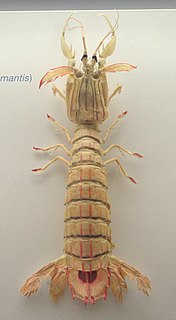
Squilla mantis is a species of mantis shrimp found in shallow coastal areas of the Mediterranean Sea and the Eastern Atlantic Ocean: it is also known as "pacchero" or "canocchia". Its abundance has led to it being the only commercially fished mantis shrimp in the Mediterranean.

The shrimp scad, is a species of widespread tropical marine fish of the jack family, Carangidae. The shrimp scad is widely distributed in the tropical and subtropical western Indian Ocean and areas of the eastern Pacific Ocean, ranging from South Africa in the west to Hawaii in the east, including Japan and Australia to the north and south. The species is commonly found on inshore reefs and sandy substrates. It has the common body profile of a scad, and may be difficult to differentiate from others in the genus Alepes. It is one of the larger scads, growing to 40 cm, but often is encountered at much smaller sizes. The shrimp scad often forms large schools, and is carnivorous, consuming a variety of crustaceans and small fish. It is of moderate importance to fisheries throughout its range.

The duskyshoulder trevally or epaulet trevally, is a species of small inshore marine fish in the jack family, Carangidae. It is distributed through the eastern Indian and western Pacific Oceans, ranging from eastern India to northern Australia and Taiwan. It is relatively small by carangid standards, reaching only 27 cm maximum length, and can be distinguished by the large, black blotches on its shoulders. The duskyshoulder trevally is an inshore fish living in waters less than 50 m deep, over sandy substrates in bays and on the continental shelf. It is a predatory fish, taking demersal fishes, crustaceans, and cephalopods, with nothing known of its reproductive habits. It is of little value to fisheries, often taken as bycatch in prawn trawling operations.

The common stingray is a species of stingray in the family Dasyatidae, found in the northeastern Atlantic Ocean and the Mediterranean and Black Seas. It typically inhabits sandy or muddy habitats in coastal waters shallower than 60 m (200 ft), often burying itself in sediment. Usually measuring 45 cm (18 in) across, the common stingray has a diamond-shaped pectoral fin disc slightly wider than long, and a whip-like tail with upper and lower fin folds. It can be identified by its plain coloration and mostly smooth skin, except for a row of tubercles along the midline of the back in the largest individuals.

The lesser electric ray, also known as the Brazilian electric ray, small electric ray, spotted torpedo ray, torpedofish or trembler, is a species of numbfish in the family Narcinidae found on the western coastal fringes of the Atlantic Ocean and Caribbean Sea. It is a small slow-moving fish, living in the surf zone of sandy or muddy beaches. Here it is easily caught as bycatch by shrimp fisheries and seine netters. The International Union for Conservation of Nature has rated it as being of "least concern".
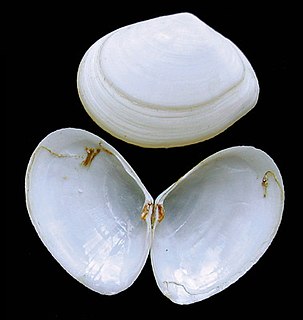
Abra alba, or the white furrow shell, is a species of bivalve mollusc in the family Semelidae. It occurs in the northeastern Atlantic Ocean and the Mediterranean Sea, where it lives on the floor in shallow areas buried in soft sediments.
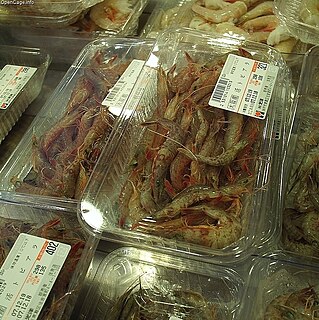
Trachysalambria curvirostris is a species of prawn that lives in shallow waters of the Indo-West Pacific. It is one of the most important species targeted by prawn fishery, with annual harvests of more than 300,000 t, mostly landed in China.

Farfantepenaeus duorarum is a species of marine penaeid shrimp found around Bermuda, along the east coast of the United States and in the Gulf of Mexico. They are a significant commercial species in the United States and Cuba.

Metapenaeus monoceros is a species of prawn in the family Penaeidae. It is also known as speckled shrimp, brown shrimp and pink shrimp in English, crevette mouchetée in French, camarón moteado in Spanish, koraney chingri or honye chingri in India, ginger prawn in South Africa and choodan chemmeen in Malayalam.
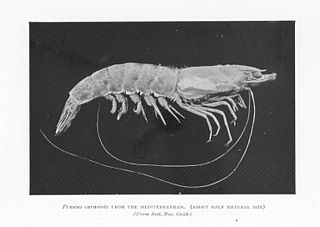
Melicertus kerathurus, the striped prawn or caramote prawn is a species of tiger prawn from the family Penaeidae which occurs in the eastern Atlantic and Mediterranean Sea which is an important species in commercial fisheries. It is the type species for the genus Melicertus.

Penaeus semisulcatus, the green tiger prawn or grooved tiger prawn, is a commercially important species of prawn in the genus Penaeus.
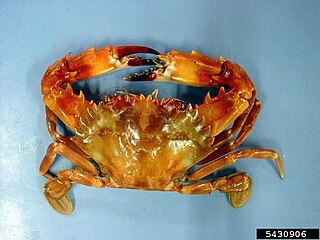
Charybdis hellerii, the Indo-Pacific swimming crab or spiny hands is a species of crab from the swimming crab family, the Portunidae. Its native range covers the Indian and Pacific Oceans but it has been introduced to the western Atlantic and has invaded the Mediterranean. It is a commercially exploited species in south-east Asia.

Nemipterus randalli, or Randall's threadfin bream, is a species of ray-finned fish from the family Nemipteridae, the threadfin breams, which is native to the western Indian Ocean and the Red Sea, it has invaded the eastern Mediterranean by Lessepsian migration through the Suez Canal.



















